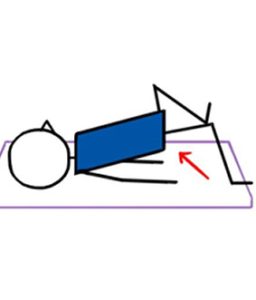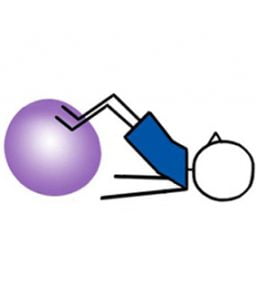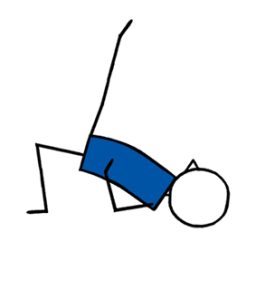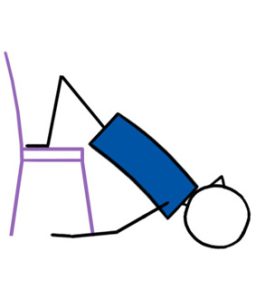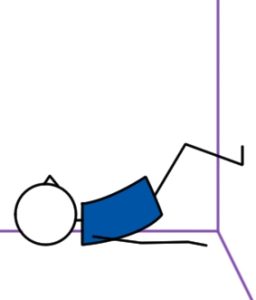
| Category: | Pilates Lesson Planner |
|---|---|
| Sub Category: | Reformer |
| Types: | Arm Balance, Back Bend, Balance, Chest Opener, Hip Opener, Inversion, Object, Seated & Floor, Stretch, Supine |
| Anatomy: | Arms & Shoulders, Core, Hamstrings, Hips, Knees, Middle Back, Neck, Psoas, Wrists & Arms |
| Chakras: | Crown Centre, Heart Centre, Solar Plexus Centre, Third Eye, Throat Centre |
| Therapy: | Anxiety, Back Pain, Confidence Building, Depression, Headaches, Indigestion, Poor Posture, Stress, Varicose Veins |
| Drishti: | Up |
| Dosha: | Pitta, Vata |
Supine, with legs parallel and abducted in line with sit bones. Heels on the footbar, ankles dorsiflexed, arms lengthened down by hips, palm, down, neutral pelvis and spine. Headrest must be down. Inhale. On exhale roll the spine, one vertebra at a time, in a bridge until you've reached a diagonal from your shoulders to your knees. Roll down in the same pattern.
Improves spinal articulation into flexion, segmental spine mobility. Improves hip extensor strength, and lengthens hip flexors and spinal extensor muscles.
A) Bridge on a Swiss ball. B) Bridge on foam roller. C) Bridge on Arc. D) Bridge with leg raises
Neck injury.
Click here for lots of FREE downloadable Yoga lesson plans.
Click here for lots of FREE downloadable Pilates lesson plans.
- Reformer FLow
- Flow 1.0
- CP Reformer Flow 1 Basic
- Club Pilates - Reformer Postures
- DENA 10
- Flow 1.0
- Final reformer
- Karen's lesson
- Pilates class New Year
- Day One
- 15 minute
- Flow 1.0
- Week 1 Pilates
- Day One
- Teacher Training Katie
- CP Reformer Flow 1.0 - 02.17.24
- Special population Knees
- CP Reformer Flow # 5th March 2024
- Reformer
- Reformer Pilates
- code of pilates-lesson without limitations
- Reformer FLow
- Beginner 1
- CP Reformer Flow 1-1
- Reformer Pilates Beginner
- Reformer Signature MK
- REFORMER ADVANCED KL
- Reformer Pilates Beginner
- Reformer Beginner - KL
- REFORMER SIGNATURE - KL
- REFORMER SIGNATURE MM
- Beginner 1 MM
- 10-15 Minute Flow
- REFORMER ADVANCED KL
- Aidan Murphy
- Reformer plan 1
- Reformer plan 1 - with springs
- Reformer plan 1 - with springs
- Ask Genie 4
- Easy Intro to Pilates
- Part III: Psoas & Upper Body
- Reformer 1.0
- core
- core
- CP Reformer Flow 1-1
- Classic Flow Reformer
- Reformer plan 1 - with springs
- reformer icons
- reformer icons
- CP Reformer Flow 1-1
- SHEF Reformer Flow 1
- Classic Flow Reformer
- Sunday 17/11/24
- Celtic Session 4
- 45 MINUTE – REFORMER FLOW FULL BODY
- Classic Flow Reformer
- 45 Min Session - Celtic Week 1
- Celtic Session 5
- Pilates Essentials
- Pilates Essentials: FW & Bridge
- Classic Flow Reformer
- Beginner Reformer
- Basic Long Class Plan
- All Reformer Excersises
- Celtic Session 4
- Easy: Back focus
- Practice Teaching Flow 1 - January 2025
- Pilates 1
- Reformer- Beginner 2- Malea
- Reformer. Class 2
- All Reformer Exercises
- Pilates 1 arms
- Classic Flow Reformer
- 45 Min Session - Celtic Week 1
- Classic Flow Reformer
- CP Flow 1 Test Out
- Copy Practice Teaching Flow 1
- PAUSE code of pilates-lesson without limitations
- Pilates Reformer Test (Spike)
- 45 MINUTE – REFORMER FLOW FULL BODY
- Reformer Flow Beginner
- Reformer Flow Beginner
- Reformer Exercises
- Legs 11
- Classic Flow Reformer Reformer 1
- 45 MINUTE – REFORMER FLOW FULL BODY
- 45 MINUTE – REFORMER FLOW FULL BODY
- Classic Flow Reformer
- Ask Genie 1
- 45 MINUTE – REFORMER FLOW FULL BODY
- 45 MINUTE – REFORMER FLOW
- Flow 1.5 ideas - delete
- 45 MINUTE – REFORMER FLOW
- 45 MINUTE – REFORMER FLOW
- Reformer 1 ABS & ARMS
- Pilates Test Lesson 1
- Special population Knees
- All Reformer Excersises
- workshop flow
- 45 MINUTE – REFORMER FLOW
Bridging on the Pilates Reformer: Elevate Your Core Strength and Flexibility
Bridging on the Pilates Reformer is also known as “Pelvic Lift” and “Bottom Lift”. It is a progression to bridging on the mat. It requires more hamstring and glute strength. The heavier the springs the easier, because the carriage is more stable.
Pilates is a holistic approach to fitness that emphasizes core strength, flexibility, and overall body awareness. One of the key exercises that embodies these principles is the bridge, and when performed on the Pilates Reformer, it takes your workout to a whole new level.
In this blog, we’ll explore the benefits of bridging on the Pilates Reformer, the correct technique, and how it can help you achieve your fitness goals.
Understanding the Pilates Reformer
Before diving into “Bridging on the Pilates Reformer”, it’s essential to understand what the Reformer is and how it works. The Pilates Reformer is a piece of exercise equipment designed to enhance the effectiveness of Pilates exercises. It consists of a frame with a moving carriage, springs, straps, and a footbar. The resistance provided by the springs allows for controlled and precise movements, targeting specific muscle groups while supporting the body’s alignment.
The Benefits of Bridging
Bridging is a fundamental Pilates exercise that offers a wide range of benefits for practitioners of all levels. When performed on the Reformer, these benefits are amplified:
Core Strength: Bridging engages the deep abdominal muscles, including the transverse abdominis and obliques, to stabilize the pelvis and spine. This helps to develop a strong core, which is essential for maintaining proper posture and preventing lower back pain.
Glute Activation: The bridge primarily targets the gluteus maximus, the largest muscle in the buttocks. Strengthening this muscle not only helps improve your appearance but also contributes to better hip stability and overall lower body strength.
Spinal Mobility: Bridging on the Pilates Reformer encourages spinal articulation, promoting flexibility and mobility in the spine. This can be especially beneficial for individuals who spend long hours sitting at a desk or have a history of back issues.
Improved Posture: As you work on your core strength and spinal mobility, you’ll find that your posture naturally improves. Good posture is not only aesthetically pleasing but also reduces the risk of musculoskeletal problems.
Balance and Coordination: Bridging on the Reformer challenges your balance and coordination. The moving carriage and the resistance from the springs require precise control of your movements, enhancing your overall body awareness.
Full-Body Workout: While the bridge primarily targets the core and glutes, it also engages the hamstrings, quadriceps, and calf muscles. This provides a comprehensive full-body workout, making it an excellent addition to any fitness routine.
Proper Technique for Bridging on the Pilates Reformer
To reap the full benefits of bridging on the Pilates Reformer, it’s crucial to execute the exercise with proper form. Here’s a step-by-step guide to help you get started:
Set up the Reformer: Begin by adjusting the spring tension to an appropriate level. The specific setting may vary depending on your fitness level and the Reformer you’re using. Consult with a certified Pilates instructor if you’re unsure.
Lie down: Lie on your back with your feet resting on the footbar. Your heels should be hip-width apart, and your toes should be pointing forward.
Neutral spine: Ensure your spine is in a neutral position, with a slight natural curve in your lower back. Your arms should be by your sides, palms facing down.
Engage your core: Prioritize engaging your deep abdominal muscles. Imagine drawing your navel towards your spine to activate your transverse abdominis.
Begin the movement: Press your feet into the footbar and lift your hips off the carriage. As you do this, maintain the engagement of your core and avoid arching your back excessively.
Full bridge: Continue lifting your hips until your body forms a straight line from your shoulders to your knees. Your weight should be evenly distributed between your feet and shoulders.
Lower with control: Slowly lower your hips back down to the starting position, keeping your core engaged throughout the movement.
Repeat: Perform the exercise for the desired number of repetitions, typically 8-12, depending on your fitness level and goals.
Tips for Success
Focus on your breath: Inhale as you prepare to lift, and exhale as you engage your core and lift your hips.
Maintain alignment: Keep your knees aligned with your hips and your feet parallel. Avoid letting your knees splay outward.
Gradually increase resistance: As you become more comfortable with the exercise, you can increase the spring tension to intensify the workout.
Seek guidance: If you’re new to Pilates or the Reformer, consider working with a certified instructor to ensure proper form and technique.
Variations and Progressions
Once you’ve mastered the basic bridge on the Pilates Reformer, you can explore variations and progressions to continue challenging yourself:
Single-leg bridge: Lift one leg off the footbar while performing the bridge to increase the demand on your core and glutes.
Bridge with Pulses: At the top of the bridge, add small pulses by lifting and lowering your hips slightly to intensify the workout.
Elevated Bridge: Elevate your feet on a box or wall to increase the range of motion and add a new dimension to the exercise.
Weighted Bridge: Hold a small dumbbell or weight plate on your hips while performing the bridge to add resistance and increase the challenge.
Bridge with Leg Variations: Experiment with different leg positions, such as turned-out or parallel, to target different muscle groups.
Bridge on a Swiss Ball: Position back on Swiss Ball with legs and arms extended. Take a deep breath and feel the stretch move into your rib cage, chest and shoulders. Hold for 30 seconds. Release by rolling forward.
Bridge with a Circle: Lie on your back. Knees bent with feet on the floor. Rest magic circle between hip bones. Place hands on top of the ring. Press hips up against the ring. Straighten one leg. Bring your leg down. Lower hips. Repeat by alternating between legs.
Bridge with Mini Ball: Lie on your back, knees bent. Place the mini ball between the knees, hands beside the body, grazing heels. Squeeze butt, lift hips. Squeeze the ball, and extend the left leg towards the wall. Alternate between lifting and lowering hips without moving the leg. Repeat on the right leg.
In Conclusion
Bridging on the Pilates Reformer is a powerful exercise that can transform your core strength, flexibility, and overall fitness.
By adding this exercise to your regular Pilates routine, you’ll not only experience physical benefits but also enhance your body awareness and alignment. Remember that proper form and technique are crucial, so consult with a certified Pilates instructor to get started safely and effectively.
As you progress, you can explore variations and progressions to keep your workouts engaging and challenging. So, elevate your fitness journey with “Bridging on the Pilates Reformer” and unlock a stronger, more flexible, and healthier you.




 Yoga Lesson Planner
Yoga Lesson Planner
 Pilates Lesson Planner
Pilates Lesson Planner
